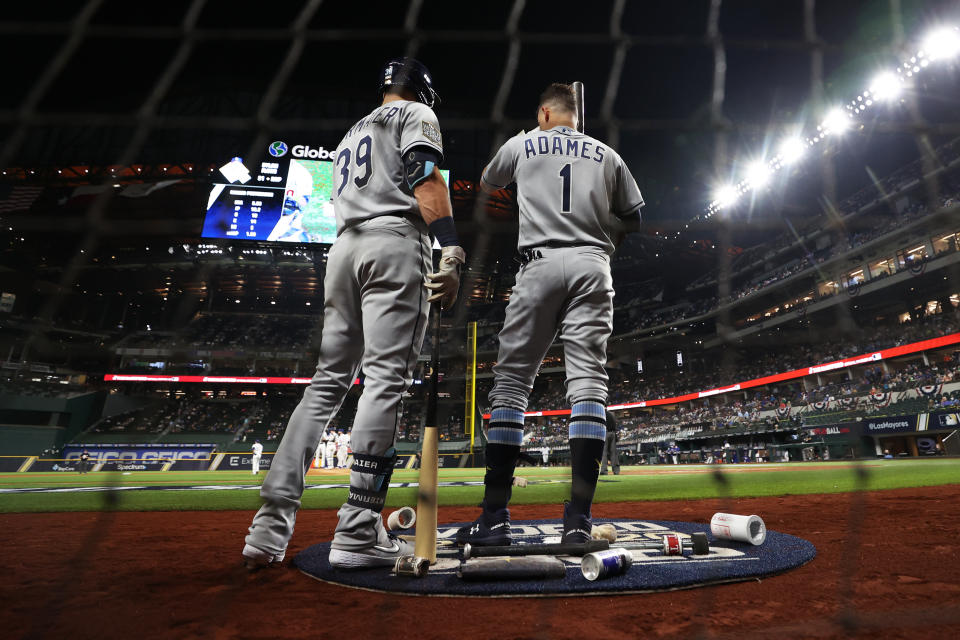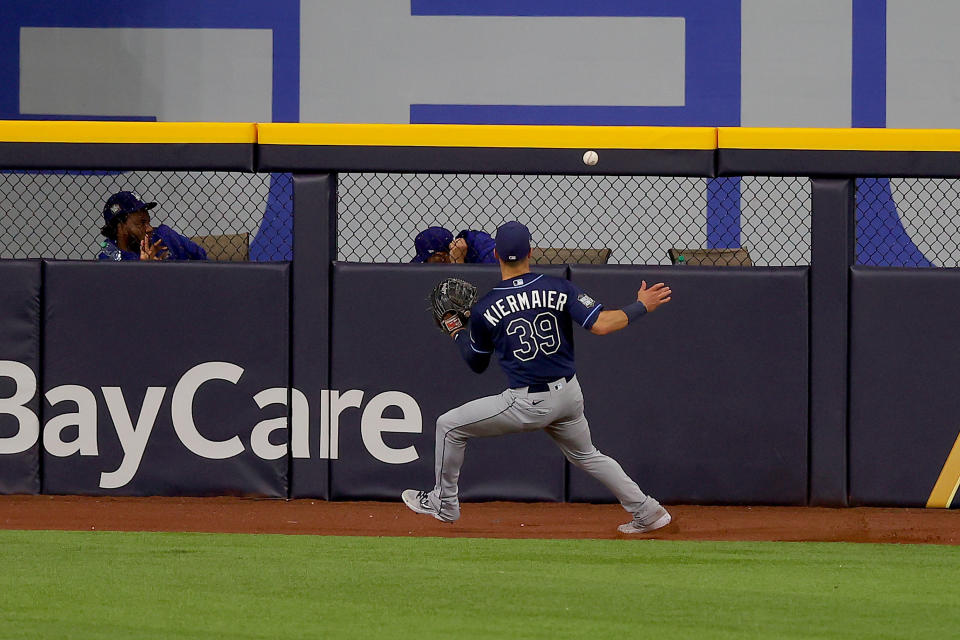Why the Dodgers still have a home-field advantage, and what the Rays are doing about it
Tonight, the Tampa Bay Rays play their first World Series game of the year as the home team. They’ll wear white and bat last, but, of course, as all postseason games have since the first round, Game 3 will take place at a neutral site. Except that Globe Life Field in Arlington, Texas, isn’t quite neutral and if anyone has home-field advantage, it’s the Dodgers.
No one on the Rays had been inside the stadium where the entirety of the World Series will be played before Oct. 19. The ballpark is brand new this year, opened just in time for baseball to be put on hold for a few months before a 60-game regular season in which the Texas Rangers only hosted teams in the West divisions. The Dodgers played a three-game series there in late August and have practically moved in for the postseason.
This month, the Los Angeles Dodgers have been in Arlington since the Division Series, playing 10 games over two weeks in Globe Life. The Rays arrived in time for one workout before the World Series started.
“I mean, as much as we played and practiced on this field,” Dodgers manager Dave Roberts said, “I think it's an advantage.”
Not all the Rays players and coaches are willing to concede that point.
“No, I'm not overly concerned that it gives them the advantage,” manager Kevin Cash said. “The Dodgers are really good regardless of where we're playing.”
“I wouldn’t say that's an advantage for them,” Willy Adames said. “It’s just another big league field.”
“I know we’ll adjust,” Austin Meadows said.
They absolutely will, or already have, or are somewhere in the process of doing so. Adjustment is integral to success in sports. But to adjust, you need to know what you’re adjusting to.
“I mean, [the Dodgers are] comfortable,” Blake Snell said. “They’ve been at this hotel for two weeks now. They've been playing here for a while, they know how the field works, so they're probably a little more comfortable.”
“I think it would be a lame excuse to say it was unfair,” said Jeremy Sowers, the Rays manager of major league operations. And so he didn’t say that it was unfair. But it is something — something that they have to contend with, at the very least. In the lead-up to the World Series, it was a cross-department effort to advance scout a practically brand new stadium without a track record of park factors, and in a year with prohibitive travel restrictions.
“It's one of those things where you feel really weird doing it because it feels like a jinx, when you're trying to be very ahead of things,” Sowers said.

Studying Globe Life Field
The advance work started long before the Rays knew they would be playing in the franchise’s second Fall Classic. As the team finished out the regular season with the American League’s best record and battled through an expanded postseason gauntlet, sweeping the Blue Jays before going the distance in five games against the New York Yankees and seven against the Houston Astros, some pro scouts and front office staff had their sights set on Arlington and the opponents the Rays could face there.
As part of the pandemic precautions, MLB banned scouts from ballparks this season. The drawbacks are obvious, for trades, and evaluating opponents, and advance scouting stadiums like Globe Life Field. Instead, everything had to be done over video, at the mercy of MLB angles — which are fortunately robust — and edits. Lighting looks different on camera than it might in person. It’s harder to gauge how the wind affects the flight of the ball and how the retractable roof affects the wind.
But one upside was the availability of pro scouts who would usually be traveling.
“We brought them into this,” Sowers said. Six to 10 scouts researched all of the potential postseason opponents, a group that got whittled down and redistributed as teams were eliminated.
“So by the time we got to the ALCS, we put half of them on the Dodgers, half of them on the Braves. And obviously, both of them were able to care and pay attention to the park factors because they're playing in the same spot.”
“You'd be surprised,” Sowers said about how much can be gleaned, just from watching games intently, about the stadium they’d yet to experience. “One example from Texas is seeing the wind blowing the pitchers pant legs and kind of being like what's going on there? Watching guys make certain plays to learn how balls can carom off walls, the height of walls, how that impacts foul territory. I mean, there's all sorts of stuff that you can just visualize by paying attention. And those guys did a wonderful job with that.”
As the team got closer to the World Series itself, members of the Rays’ front office from GM Erik Neander down reached out to people they knew around the industry who were more familiar with Globe Life Field — at the Rangers, naturally, but also teams that played there either in the regular season or postseason.
“I think that the fact that our group has a lot of connections throughout the game, you can ask five to 10 people the same question and when you start getting answers that become redundant, you know there's some signal to that and then we can probably feel good about relaying that information on to Kevin [Cash] and then the players,” Rays pro scouting director Kevin Ibach said.
Everything the advanced scouting team was able to deduce was presented to the players and field staff in a slideshow presentation over Zoom.
“You can tell your players every single thing that you see,” Sowers said, “but it's gonna be really hard to have it be fully impactful until they're out there doing it.”

Testing every nook and cranny
On Monday, they were finally able to go out there and do it — a workout that is — gaining access to Globe Life Field, where their World Series fate will be determined in the coming days.
“It's a wonderful stadium, and the Rangers should be commended for it,” Ibach said. “But yeah, certainly when we got here off the plane yesterday, the first thing we did was go to the ballpark and literally hit and throw balls off of every wall, netting, every nook and cranny of that ballpark we tried to explore in our workout there. Because no matter how much work we do ahead of time, and scouting it, and doing our research on it, it never can take the place of actually being there and seeing it.”
Kyle Snyder, the pitching coach, went right for the mound to check out the perspective. Mike Zunino thought that the turf didn’t feel quite as bouncy as it does at the Trop, even though it’s supplied by the same company. Ibach, too, thought it felt faster just walking around on it. There are sunken club seats down the line that cut into foul territory, and both Sowers and Ibach were unsure exactly how those would affect play.
Shagging flies, normally eyewash in batting practice, took on a new level of importance as the outfielders practiced reacting to how the ball comes off the bat in that environment.
“Kevin Kiermaier is really, really good at doing that stuff,” Sowers said.
Defense has been one of the flashier deciding factors in the Rays’ success this postseason, the kind of aggressive catches where a practiced sense of your surroundings necessarily comes into play. The team didn’t have a ton of experience at Petco Park going into the ALDS and ALCS, but Manuel Margot’s time with the Padres was on display as he literally dove over walls to get an out without getting injured.
WOW... INSANE CATCH BY MANNY MARGOT 🤯 pic.twitter.com/mMqdIZjd8c
— FOX Sports: MLB (@MLBONFOX) October 12, 2020
Often it’s hard to measure stakes of a player’s comfort in a particular ballpark. Maybe knowing intuitively how the ball will bounce out of a corner saves a single from turning into a double, a double from turning into a triple. In the first two games of the series, there haven’t been any egregious incidents of the Rays failing to field a ball cleanly. But for two teams who have proven themselves well-matched, the cumulative effect of inches could become decisive.
“They have familiarity that we don't have with this ballpark by playing here. So I certainly wouldn't want to downplay that,” Ibach said.
But the Rays have gotten this far by beating teams in better circumstances and they’re confident they can do it again.
“I'd like to think that whatever disparity there was on the familiarity side,” he said, “that gap kind of narrowed as best as we could make it through the efforts of a lot of people within the Rays.”
More from Yahoo Sports:

